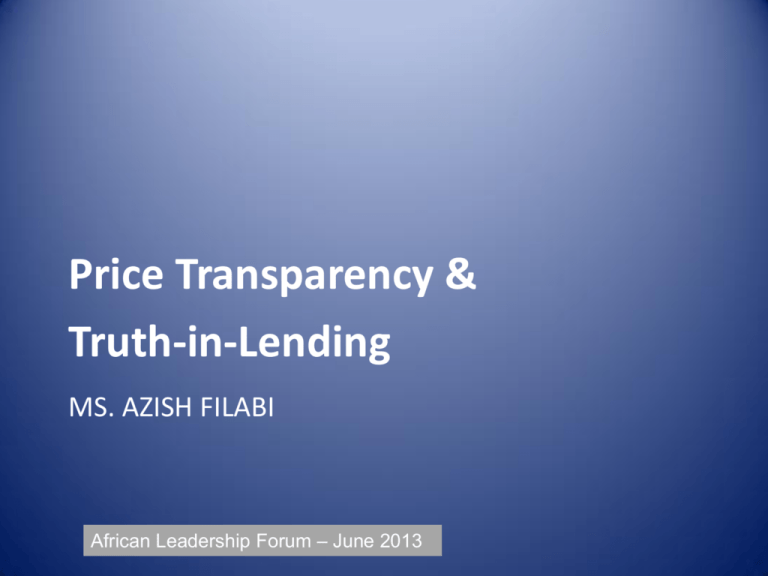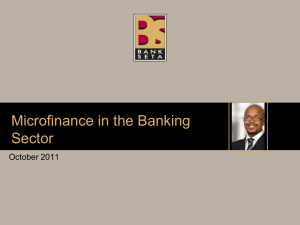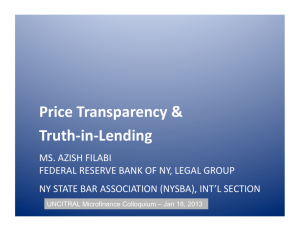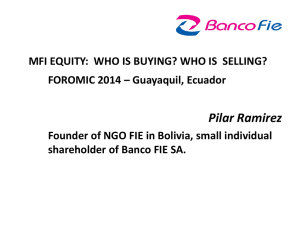Price Transparency & Truth-in-Lending
advertisement

Price Transparency & Truth-in-Lending MS. AZISH FILABI African Leadership Forum – June 2013 Disclaimer The views expressed in this presentation are solely my own Why is transparency important? Hidden Prices!! Theory of Truth-in-Lending • It is a disclosure standard (not a price control) • Consistent with free market economic principles, disclosure ensures that both borrower and lender have the same information – Fixes a market distortion caused by information asymmetry – In theory, in a transparent market, prices should converge Why legislation? • Stakeholder incentives: – Lenders– want to reach more clients, therefore incentive to provide lowest sounding price (hidden fees) – Investors – want higher volume and higher returns – Client – wants the best deal, but may not know what to ask for • Mandatory participation required for a disclosure regime to work efficiently – Self-regulation is voluntary – Transparency works best when consistent – clients should be able to compare the same information, ideally in the same format Why legislation? • Self-regulation has no enforcement mechanism – Reliance on market forces to distinguish among MFIs – Self-regulation demonstrates a commitment to responsible finance, which is a important step for truth-in-lending laws to work effectively • The main benefits to competition and fair access come from all lenders adhering to the same rules Legal Considerations & Best Practices Legal Considerations 1. 2. 3. 4. Standard Pricing Formulas Standard Repayment Schedules Enforcement & Sanctions Financial Education/Communication Mechanisms 1. Standard Pricing Formulas • Why a standard formula? – Beneficial to clients when all lenders use the same formula (so borrowers can compare “apples to apples”) • What disclosure standard? – Nominal rates: dismissed because it does not provide adequate disclosure of the “real” rate – APR vs. EIR vs. Total Cost of Credit? APR is a best practice – Should flat interest rates be prohibited? – Mandatory savings accounts to be included in cost calculations? 1. Standard Pricing Formulas • What fees disclosed? – Best practice would require ALL origination or repayment fees to be communicated • How to best disclose bundled services?: – Insurance – Mandatory savings; voluntary savings • Other Terms & Conditions – Prepayment penalties? – Variable or fixed interest rates? 1. Standard Pricing Formulas Philippines • Bangko Sentral ng Pilipinas (Central bank) regulates microfinance “banks” (General Banking Law of 2000) – microfinance market has non-bank microfinance lenders, and also traditional commercial banks – www.frbsf.org/publications/.../2010/january.pdf • The Truth In Lending Act (Republic Act 3765) (1963) – Applies to all “creditors” • Flat interest rates prohibited (Circular No. 730, Series of 2011) – “Banks may only charge interest based on the outstanding balance of a loan at the beginning of an interest period.” ( 1. Standard Pricing Formulas Philippines • Mandatory disclosures – Definitions: – “Finance charge includes interest, fees, service charges, discounts and such other charges incident to the extension of credit” (Circular No. 730) – Permitted to use EIR or MPR (may confuse the market) • “…effective interest rate (EIR) is the rate that exactly discounts estimated future cash flows through the life of the loan to the net amount of loan proceeds (Circular No. 730; see examples in Memorandum M2011-040)” • “for loans with contractual interest rates stated on a monthly basis, the EIR may be expressed as a monthly 1. Standard Pricing Formulas • How to further protect consumers?: – Prohibit a mandatory security interest/collateral accounts Legal Considerations 1. 2. 3. 4. Standard Pricing Formulas Standard Repayment Schedules Enforcement & Sanctions Financial Education/Communication Mechanisms 2. Standard Repayment Schedules • Why standard? – Standard forms make it easier to compare across lenders, irrespective of entity type – For illiterate clients, a standard form makes it easier to compare offerings even if they don’t necessarily understand all the terms 2. Standard Repayment Schedules • Should forms be mandatory or used at the discretion of the lender (a safe harbor)? – Mandatory use will ensure consistency – Safe harbor reduces compliance costs and provides opportunity for experimentation • What level of detail in the forms? – Balance of too much info vs. sufficient info (risk confusing clients) – Only APR/EIR/TCC? – Include cash flow details? 2. Standard Repayment Schedules Philippines • Disclosure mechanisms: – Mandatory disclosure of the following information: 1) the cash price or delivered price of the property or service to be acquired; (2) the amounts, if any, to be credited as down payment and/or trade-in; (3) the difference between the amounts set forth under clauses (1) and (2); (4) the charges, individually itemized, which are paid or to be paid by such person in connection with the transaction but which are not incident to the extension of credit; (5) the total amount to be financed; (6) the finance charge expressed in terms of pesos and centavos; and (7) the percentage that the finance bears to the total amount to be financed expressed as a simple annual rate on the outstanding unpaid balance of the obligation. – Provides a disclosure statement (unclear whether this is just a suggested standard) – Disclosure form requires a signature – Borrower’s rights must be posted on business premises Legal Considerations 1. 2. 3. 4. Standard Pricing Formulas Standard Repayment Schedules Enforcement & Sanctions Financial Education/Communication Mechanisms Enforcement & Sanctions • Disclosure regimes will require enforcement & sanctions to be most effective • Various enforcement regimes & models to be explored by the Working Group: – Recommendations will differ based on regulatory landscape & scale of lending in each jurisdiction Enforcement & Sanctions • Example – United States • entities that are prudentially supervised are often sanctioned by the licensing or supervisory agency (OCC, FDIC, State Banking Dep’t, Federal Reserve); and • ALSO subject to supervision by agencies with legal jurisdiction over their activities or financial products (Consumer Financial Protection Bureau; Federal Trade Commission); • ALSO can be subject to sanction by the State Attorney General’s office; AND • Borrowers have remedies under the Truth in Lending Laws Enforcement & Sanctions • U.S.: Remedies for consumers under US Truth in Lending law – Rescission: Right to rescind (cancel) a loan where a customers principle dwelling is taken as collateral, other than transactions for purchase of a home. Commonly rescinded transactions include home equity loans, loans for home improvement, and refinance loans. The right exists for 3 days, and in some cases can go up to 3 years [if important TILA disclosures were not made] – Actual damages (must prove how much); individual statutory damages (ranging from $200 to $4,000); class action statutory damages; and attorney fees; and sometimes injunctive relief (common law remedy) – Regulators can impose enforcement actions on entities that do not comply Enforcement & Sanctions Philippines • • Statutory Damages: (a) Any creditor who in connection with any credit transaction fails to disclose to any person any information in violation of this Act or any regulation issued thereunder shall be liable to such person in the amount of P100 or in an amount equal to twice the finance charged required by such creditor in connection with such transaction, whichever is the greater, except that such liability shall not exceed P2,000 on any credit transaction. Action to recover such penalty may be brought by such person within one year from the date of the occurrence of the violation, in any court of competent jurisdiction. In any action under this subsection in which any person is entitled to a recovery, the creditor shall be liable for reasonable attorney's fees and court costs as determined by the court. Criminal Sanctions & Penalties: (c) Any person who willfully violates any provision of this Act or any regulation issued thereunder shall be fined by not less than P1,00 or more than P5,000 or imprisonment for not less than 6 months, nor more than one year or both. • Republic Act No. 3765 Others Practices India • Microfinance Crisis (Andra Pradesh) – Over-lending: cases of multiple MFIs borrowing from multiple microfinance institutions – Loans were insured, so some borrowers that couldn’t repay thought that their family would be better-off if the borrower committed suicide – Aggressive collection practices by some MFIs – Much coverage in the press; government intervened to close many branches and later responded with regulations India • Reserve Bank of India (central bank) initiated new consumer protection regulations • Begin to regulate Non-bank Microfinance Financial Companies (DNBS.CC.PD.No. 250/03.10.01/2011-12) • Ban flat interest rates (Sec 4.C.a.ii of 2011 Directive) – “Interest on individual loans will not exceed 26% per annum and calculated on a reducing balance basis” • Prohibit use of mandatory security deposit collateral accounts (Sec 4.C.b.i.c) – “MFIs shall not collect any Security Deposit/Margin from the borrower” India • Caps – 2011: for individual loans, interest rate cap of 26% + 1% max fees + 12% margin cap (insurance fees can be charged separately) • Loan pricing can only be impacted by the interest charge, the 1% processing fee, + insurance premiums (including their administrative fees) – 2012: to allow operational flexibility, they loosened the interest rate cap • average interest rate on loans during a year does not exceed the average borrowing cost during the year + the margin cap • Reduced margin cap to 10% for large MFIs (loan portfolio exceeding Rs. 100 crore); 12% for smaller India • Mitigate over-lending to same borrowers – “not more than 2 non-bank MFIs should lend to the same borrower” – “a borrower cannot be a member of more than one Self Help Group/Joint Liability Group” • Recovery methods – Recovery at a borrower’s place of residence only if borrower fails to appear at designated place on 2 or more occasions – MFIs shall have a Code of Conduct in force U.S. • New Consumer Financial Protection Bureau (CFPB), part of the DoddFrank Act • U.S. truth in lending law focuses only on consumer lending • Various laws address transparency – the laws are aimed at categories of credit: - for example: – Reg C – Home Mortgage disclosure – Reg Z – Truth in Lending (consumer loans, including mortgages) – Reg B – Equal Credit Opportunity Act (applies to all lending, i.e., anyone who is a “creditor” under the law) – Reg E – Electronic Fund Transfers – applies to all entities that hold accounts belonging to a consumer for fund transfer purposes • CFPB has engaged in an initiative to streamline disclosures – consumers had received too much information U.S. • Finance Charge definition (TILA, Section 106) – “…the amount of the finance charge in connection with any consumer credit transaction shall be determined as the sum of all charges, payable directly or indirectly by the person to whom the credit is extended, and imposed directly or indirectly by the creditor as an incident to the extension of credit…” – “Examples of charges which are included in the finance charge include any of the following types of charges which are applicable: (1) Interest, time price differential, and any amount payable under a point, discount, or other system or additional charges; (2) Service or carrying charge; (3) Loan fee, finder’s fee, or similar charge; (4) Fee for an investigation or credit report; (5) Premium or other charge for any guarantee or insurance protecting the creditor against the obligor’s default or other credit loss; (6) Borrower-paid mortgage broker fees, including fees paid directly to the broker or the lender (for delivery to the broker) whether such fees are paid in cash or financed” • Annual Percentage Rate definition (TILA, Section 107) – “…that nominal annual percentage rate which will yield a sum equal to the amount of the finance charge when it is applied to the unpaid balances of the amount financed, calculated according to the actuarial method of allocating payments made on a debt between the amount financed and the amount of the finance charge, pursuant to which a payment is applied first to the accumulated finance charge and the balance is applied to the unpaid amount financed…” U.S. Model Form U.S., continued • U.S. is heading towards a regime of mandatory forms: – “The CFPB believes, based on consumer testing results, that the purpose of more effective advance disclosure of settlement costs is better achieved if all lenders provide those disclosures in a standardized format that consumers can recognize and understand. Moreover, the credit terms included in the Loan Estimate facilitate and enhance the consumer's ability to shop for the best-priced loan, including settlement charges, which have a direct relationship to, and can overlap with, credit terms.” [Federal Register 37(o)(3)] Cambodia • Law on Banking and Financial Institutions (1999) – Identify microfinance lenders as banks – Prakas on Microfinance Licensing (2000), provides for compulsory MFI licensing & registration • Interest rates must be calculated on the declining balance method • For savings accounts, compounding of interest is required • Pricing information must be published on the MFI websites UNCITRAL UNCITRAL • UN Commission on International Trade Law • Est. by UN General Assembly (GA) in 1966 • Membership– elected by the GA. 60 states: – 14 African – 14 Asian – 8 Eastern European – 10 Latin American & Caribbean – 14 Western European & other states UNCITRAL • Term – 6 years. Every 3 years, terms of half of the members expire – Non-member states are permitted to attend sessions • Methods of Work – 6 Working groups (substantive issues assigned to each one) – Texts: Conventions; Model laws; Legislative guide and recommendations; UNCITRAL • Studying microfinance since 2009 – Current proposal is to consider an enabling legal environment for micro, small and medium-sized enterprises. Considering the life cycle of a MSME. – Among MSME topics: 1) simplified business formation; 2) effective dispute resolution; 3) mobile payments; 4) transparency in lending, credit reporting systems; and 5) insolvency of a MSME • Balance “over regulation” with “under regulation” – Timing of implementation will be country-specific: legislators, regulators, and local organizations are the best positioned to determine implementation but UNCITRAL is best position to provide standards Importance of Transparency AS REPORTED BY THE UNCITRAL SECRETARIAT • “A recurring theme [of the 1st Int’l Colloquium on Microfinance in 2011] was the need for measures to ensure client protection, including the prevention of unscrupulous practices and the building of financial literacy in the community generally” • “As noted, self-regulation by itself is no longer sufficient and there is an increasing consensus on the need to follow the principles of responsible finance.” • “More generally the need for transparency (e.g. interest rate disclosure, complaint procedures) in the microfinance sector was flagged.” Note by Secretariat (summary of First Int’l Colloquium on Microfinance), Legal and regulatory issues surrounding microfinance, A/CN.9/727 (2011) UNCITRAL • Potential approaches for a project on Microfinance and Related Topics: – Legislative Guide -- enables legislators and regulators to implement transparency regimes • Opportunity to identify best practices among countries and incorporate in to a Guide • A Guide is not legally binding on any States, it’s a tool to assist implementation of new laws Additional Materials Importance of Transparency AS RECOGNIZED BY THE INDUSTRY • Smart Campaign – Client Protection Principles – 2 of the 9 Principles include Transparency, and Responsible Pricing – Self-certification, and recently third party certification launched – www.smartcampaign.org • Banana Skins reports: – Reputation risk (2011) and political interference (2012) – These reports are written by practitioners in the microfinance industry based on information received by surveys of various stakeholders – Increasing perception that MFIs engage in abusive practices – Recognition that abusive practices are not only detrimental to the client but also to the long-term credibility of microfinance – http://www.citigroup.com/citi/microfinance/data/news110125b.pdf • Microfinance Rating Agencies – Planet Rating/Microrate/Microfinanza: Specialize in rating MFIs – Have added (as of 2012) client protection (including transparency, responsible pricing and effective complaint resolution) as a pillar of an MFI rating – “An MFI lives in symbiosis with its clients and its asset quality is notably based on the trust relationship created with its clients”. Planet Rating – “Client protection and other social measures are essential to the long-term success of the business…” Microfinanza Importance of Transparency OTHER REPORTS • “Countries with a strong institutional framework for microfinance (as defined by the Microscope) tend to reach more borrowers than countries with weaker institutional conditions. This observation especially holds true for countries with transparent pricing regulations and good dispute resolution mechanisms.” Global microscope on the microfinance business environment (2012), Economist Intelligence Unit. www.eiu.com/microscope2012 Financial Education • Client Education: – With transparency pricing, prices may appear higher (because all costs are now included), so clients should be educated on the differences • Lenders/MFIs may need training on how to comply with disclosure laws – Will vary by country and population Communication Mechanisms • Communication of information disclosed should be calibrated to the level of financial education of clients – See CGAP Focus Note No. 78 (March 2012), Designing Disclosure Regimes for Responsible Financial Inclusion (where they recommend consumer testing and feedback mechanisms to understand MFI clients). Communication Mechanisms • Communication Mechanisms: – Placement of required disclosure: • In loan documents? At MFI branches? In newspapers? On websites? Directly to regulators? – Working Group to consider complexities of communicating information to lower-income borrowers and their needs • Oral communication requirements? • Clients be required to acknowledge understanding? • Mandate on the timing of disclosure? Cooling off periods? Thank You!









